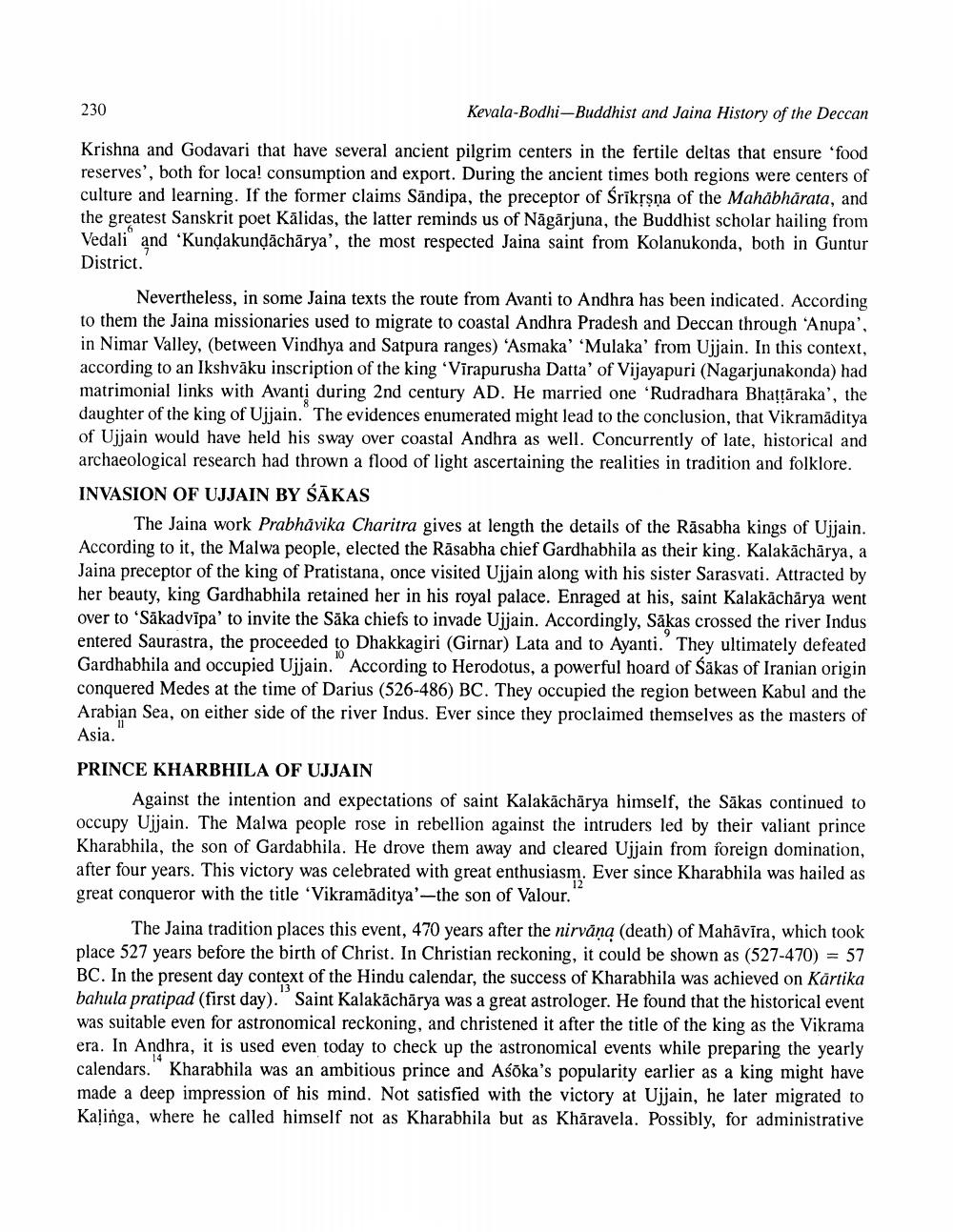________________
Kevala-Bodhi-Buddhist and Jaina History of the Deccan
Krishna and Godavari that have several ancient pilgrim centers in the fertile deltas that ensure 'food reserves', both for local consumption and export. During the ancient times both regions were centers of culture and learning. If the former claims Sandipa, the preceptor of Srikṛṣṇa of the Mahabharata, and the greatest Sanskrit poet Kalidas, the latter reminds us of Nagarjuna, the Buddhist scholar hailing from Vedali" and 'Kundakundacharya', the most respected Jaina saint from Kolanukonda, both in Guntur District.
230
Nevertheless, in some Jaina texts the route from Avanti to Andhra has been indicated. According to them the Jaina missionaries used to migrate to coastal Andhra Pradesh and Deccan through 'Anupa', in Nimar Valley, (between Vindhya and Satpura ranges) 'Asmaka' 'Mulaka' from Ujjain. In this context, according to an Ikshvaku inscription of the king "Virapurusha Datta' of Vijayapuri (Nagarjunakonda) had matrimonial links with Avanti during 2nd century AD. He married one 'Rudradhara Bhaṭṭāraka', the daughter of the king of Ujjain." The evidences enumerated might lead to the conclusion, that Vikramaditya of Ujjain would have held his sway over coastal Andhra as well. Concurrently of late, historical and archaeological research had thrown a flood of light ascertaining the realities in tradition and folklore. INVASION OF UJJAIN BY SĀKAS
The Jaina work Prabhavika Charitra gives at length the details of the Rasabha kings of Ujjain. According to it, the Malwa people, elected the Rasabha chief Gardhabhila as their king. Kalakacharya, a Jaina preceptor of the king of Pratistana, once visited Ujjain along with his sister Sarasvati. Attracted by her beauty, king Gardhabhila retained her in his royal palace. Enraged at his, saint Kalakacharya went over to 'Sakadvipa to invite the Saka chiefs to invade Ujjain. Accordingly, Sakas crossed the river Indus entered Saurastra, the proceeded to Dhakkagiri (Girnar) Lata and to Ayanti." They ultimately defeated Gardhabhila and occupied Ujjain." According to Herodotus, a powerful hoard of Sakas of Iranian origin conquered Medes at the time of Darius (526-486) BC. They occupied the region between Kabul and the Arabian Sea, on either side of the river Indus. Ever since they proclaimed themselves as the masters of Asia.
10
PRINCE KHARBHILA OF UJJAIN
Against the intention and expectations of saint Kalakacharya himself, the Sākas continued to occupy Ujjain. The Malwa people rose in rebellion against the intruders led by their valiant prince. Kharabhila, the son of Gardabhila. He drove them away and cleared Ujjain from foreign domination, after four years. This victory was celebrated with great enthusiasm. Ever since Kharabhila was hailed as great conqueror with the title 'Vikramaditya'-the son of Valour.
The Jaina tradition places this event, 470 years after the nirvana (death) of Mahāvīra, which took place 527 years before the birth of Christ. In Christian reckoning, it could be shown as (527-470) 57 BC. In the present day context of the Hindu calendar, the success of Kharabhila was achieved on Kārtika bahula pratipad (first day)." Saint Kalakacharya was a great astrologer. He found that the historical event was suitable even for astronomical reckoning, and christened it after the title of the king as the Vikrama era. In Andhra, it is used even today to check up the astronomical events while preparing the yearly calendars." Kharabhila was an ambitious prince and Asoka's popularity earlier as a king might have made a deep impression of his mind. Not satisfied with the victory at Ujjain, he later migrated to Kalinga, where he called himself not as Kharabhila but as Khâravela. Possibly, for administrative




